The A-Bomb and Humanity
■Still in the World ■Those Two Days ■Suffering and Anger ■Live in Struggle
■Still in the World ■Those Two Days ■Suffering and Anger ■Live in Struggle
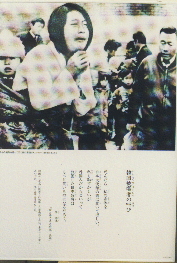
(29)Cries of the Korean HibakushaWhen I'm dead, I want my corpse to be placed in front of the Japanese Embassy.I may be ashamed, but the Japanese government, who ignored us because we were "foreigners", would be made more of a laughingstock that way. Lee Nam Su From "Guide to Hiroshima and Nagasaki for Mothers and Children" Lee Nam Su was drafted in Korea for forced labor in Hiroshima and was exposed to the atomic bomb; she (he) died in March 1975 after suffering from paralysis of her whole body. Suk Dok cries as she follows the corpse of her mother, Lee, in Seoul. | 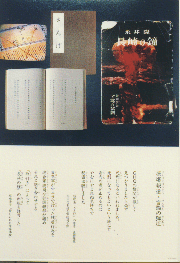
(30)Suppression of Freedom of Press and Expression about the A-bombingThe censorship enforced by the GHQ was so strict, and I was told that any violation would almost certainly lead to the death penalty. But with a strong determination even if it meant facing the death penalty, I secretly published this book, compelled by a force inside myself, though my family tried to stop me. The department of intelligence of the General Headquarters put together the record of atrocity in Manila committed by the Japanese military. Book title: (left) "Sange" (Buddhist term for "death"); (right) "The Bell of Nagasaki" (authored by Dr. Takashi Nagai, describing the tragic situation of the Hibakusha immediately after the A-bombing) | 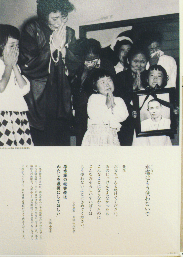
(31)Never Drop the Hydrogen Bomb AgainTeacher, Please help my daddy. If only they hadn't conducted the H-bomb test, he would not have suffered like this. Please let me be the last victim of A- and H- bombs. On March 1, 1954, many Japanese fishing boats were exposed to the fallout from the US hydrogen bomb test at Bikini Atoll in the South Pacific. Aikichi Kuboyama, the chief radio operator of the Fifth Lucky Dragon, died due to the radiation sickness. This incident triggered the rise of the anti A- and H-bomb movement in Japan. Funeral of Aikichi Kuboyama |
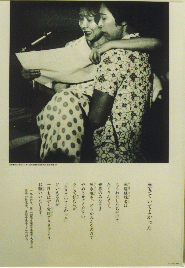
(32)We Are Glad We Have SurvivedWe want to be the last victims of the A-bombing. Appeal by Chieko Watanabe, a survivor of the Nagasaki A-bombing, at the 2nd World Conference against A- and H- Bombs held in 1956 Chieko Watanabe, Nagasaki, at the 14th World Conference against A- and Bombs | 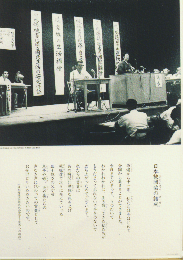
(33)Establishment of Nihon HidankyoEleven years after the A-bombing, we could finally assemble from all over the country for the first time. "Greetings to the World", Declaration of the founding conference of Nihon Hidankyo (Japan Confederation of A-and H-Bomb Sufferers Organizations) The Founding Conference of Nihon Hidankyo (August 10, 1956) | 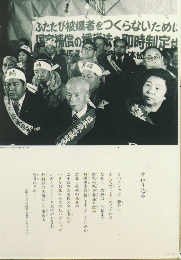
(34)Sit-inHibakusha sit-in quietly and with rage. Sit-in in Front of the Ministry of Health and Welfare, November, 1980 |
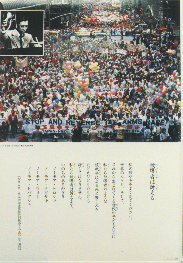
(35)Hibakusha AppealTake a close look at my face and arms. The Million March in New York, 1982 | 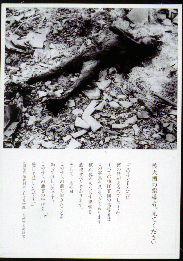
(36) Please Look at this PhotographWhat crime did these children commit? Near Ground Zero, Nagasaki | 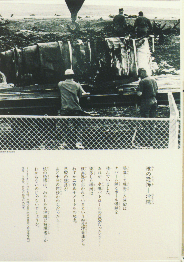
(37)Nuclear Threat: OkinawaThe B52 that crashed and exploded was carrying napalm and ball bombs. Early in the morning of November 19, 1968, a B52 bomber crashed and created a huge explosion in Kadena US Base in Okinawa. Great damage was inflicted to the surrounding houses. |
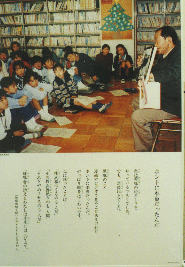
(38)It Indeed Was Real"I thought I knew how horrible the A-bomb was. Hearing the stories of the Hibakusha, however, I realized it was worse than I had imagined." "I have seen the A-bombing in some comic books and videos. But today I learned that it indeed was real. War is terrible." The most impressive words -- "It is human beings who build nuclear weapons" "It is human beings who use nuclear weapons" "And it is human beings who can stop them." "I will convey the appeal of the Hibakusha to the future." Cited from the essays of the children who listened to the Hibakusha tell their experiences | 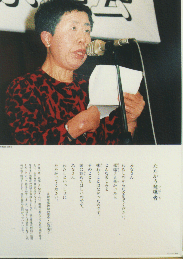
(39)Hibakusha in StruggleFriends, At age 3, Ms. Matsuya was exposed to the A-bomb, and she was injured on her head by a flying piece of roof tile triggered by the blast. Ms. Matsuya applied for official recognition as an A-bomb disease victim from the Ministry of Health and Welfare. But the state rejected her application, claiming that her injury was not caused by the radiation from the A-bomb. Ms. Matsuya filed a suit, and she won in the Nagasaki District Court. The state appealed, and the case is still pending. Hideko Matsuya | 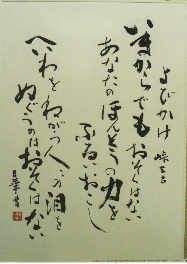
(40)CallIt is not too late yet Calligraphy: Nichika Ohmi |